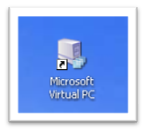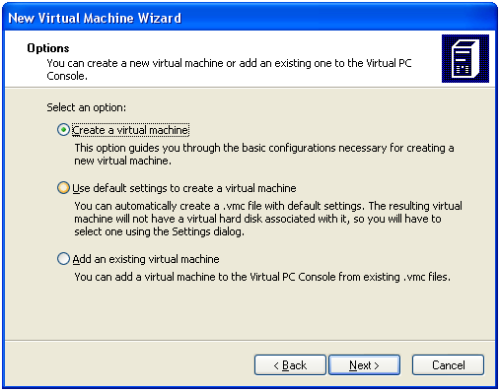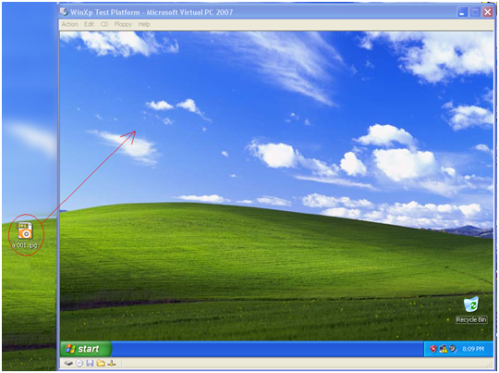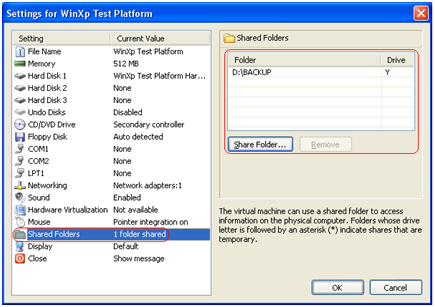Sabtu, 30 Oktober 2010
Jumat, 29 Oktober 2010
Sabtu, 23 Oktober 2010
• Install MS Virtual PC & Windows XP
Sistem operasi yang didukung dengan baik Microsoft Virtual PC umumnya adalah yang berasal dari keluarga Microsoft sendiri seperti Windows 98, XP, Vista. Untuk linux dukungannya kurang, lebih baik memakai Software virtualization yang lain seperti VMWare (sayangnya tidak gratis).
Kelemahan saat ini adalah tidak didukungnya USB drive oleh virtual PC. Pada VMWare USB Drive telah didukung.
Hari ini Saya akan melakukan demo pada platform windows XP SP2. Perlu diingat, Saya sarankan memory komputer minimal 1 giga dan free spaces minimal 10 giga. Sistem Operasi Guest dari Virtual PC memakan sejumlah besar memory dari sistem operasi host (OS dimana virtual PC berjalan).
Sebelum memulai Saya mengingatkan, yang disebut Guest adalah operating sistem pada virtual PC sedangkah Host adalah operating sistem asli/utama kalian.
Berikut adalah langkah-langkahnya :
- Download Microsoft Virtual PC 2007 SP1 dari http://www.microsoft.com/windows/downloads/virtualpc/default.mspxNote: Installer Microsoft Virtual PC juga memerlukan software pendukung seperti windows intaller 4.5 keatas dan MSXML 6.0 keatas. Pastikan kalian telah memilikinya atau instalasi tidak dapat berjalan.
- Setelah selesai mendownload, segera install. Langkah-langkah instalasi umumnya gampang (tinggal klik saja tombol Next)
- Jalankan Microsoft Virtual PC dari Start –> Program –> Microsoft Virtual PC

- Bila belum memiliki setting satu pun Virtual PC kalian akan mendapatkan Wizard seperti dibawah ini (Klik saja next)

- Pilihlah create virtual machine

- Pilihlah sebuah nama untuk guest OS kalian. Nama bebas tapi Saya menuliskan “WinXP Test Platform”

- Karena Saya akan menginstall windows, maka saya memutuskan untuk memilih windows XP dari drop down list.

- Adjust RAM menjadi 512 MB. Defaut RAM yang hanya 128 MB sangat kurang. Note: hati-hati dalam adjust RAM ini karena sejumlah inilah RAM dari host akan tersita oleh Guest. Karena inilah saya sarankan memory host OS minimal 1 giga.

- Berikutnya kalian akan membuat sebuah Harddisk untuk Guest OS. Bentuk fisik dari HDD ini sebenarnya hanyalah sebuah file. Tentu saja ukuran filenya bisa besar sekali mencapai lebih dari 2 giga bila seluruhnya telah diinstall. Pilihlah “new virtual disk”, default setting yang memberi ukuran hdd virtual sebesar 60 giga byte telah sangat memadai.


- Wizard selesai, klik saja finish. Berikutnya adalah memasukkan Windows XP CD kedalam CD Rom drive dan start virtual machine.

- Pastikan CD windows XP berada pada cdrom drive, dan start virtual machine. Ada 2 cara menjalankan virtual machine. Pertama dengan mengklik virtual machine file (*.vmc) atau Klik start pada Virtual PC Console.Note: beberapa setting pada virtual machine masih grayed out karena Guest OS belum terinstall dan belum memiliki software “Virtual Machine addition”.


- Lakukan instalasi seperti biasa (bagaimana cara menginstalasi windows XP diluar dari tutorial ini). Coba lakukan googling bila ingin mendapatkan tutorialnya.


- Setelah OS terinstall dan kalian dapat boot kedalam, waktunya menambahkan sebuah Virtual Machine Additions. Klik pada menu Action dan pilih “Install or Update Virtual Machine Additions”. Kalian akan mendapatkan warning, klik saja continue dan lakukan install. Setelah install selesai, restart system.Note: Bila kalian merasa cursor mouse terjebak dalam OS Guest (tidak bisa move ke OS Host) tekan saja tombol ALT yang disebelah kanan keyboard (jangan yang kiri!).


- Selamat kalian sudah membuat sebuah Virtual PC
 " src="http://s2.wp.com/wp-includes/images/smilies/icon_smile.gif?m=1221156833g" /> . Berikutnya adalah dasar-dasar manipulasi file
" src="http://s2.wp.com/wp-includes/images/smilies/icon_smile.gif?m=1221156833g" /> . Berikutnya adalah dasar-dasar manipulasi file
- Untuk mengcopy sebuah file dari host ke guest, klik dan drag sebuah file dari desktop/folder ke dalam virtual pc seperti pada gambar dibawah ini. Hal yang sama juga berlaku bila kalian ingin mengcopy dari guest ke host.

- Kelemahan dari cara diatas adalah bila kalian ingin mengupdate file pada guest kemudian perubahan ini ingin juga diimplementasikan pada host maka kalian akan sering click and drag. Cara lain yang lebih baik adalah membuat sebuah shared folder. Langkahnya adalah sebagai berikut:
- Klik edit -> setting

- Ke pilihan shared folder dan buat sebuah share folder

- Kemudian untuk mengakses shared folder, gunakan windows explorer pada guest operating system dan browse ke dari Y (atau drive letter lainnya bergantung dari mapping).
-
- Menu setting juga dapat digunakan untuk mengedit nilai-nilai lain seperti besar memory etc.Note:
- USB Drive tidak didukung oleh virtual PC!
- Ukuran file virtual PC cukup besar, bahkan sudah mencapai 1,4 gb padahal baru windows yang diinstall

-
Kamis, 09 September 2010
local area network
Local area network
From Wikipedia, the free encyclopedia
Jump to: navigation, search
"LAN" redirects here. For other uses, see LAN (disambiguation).
A local area network (LAN) is a computer network covering a small physical area, like a home, office, or small groups of buildings, such as a school, or an airport. The defining characteristics of LANs, in contrast to wide area networks (WANs), include their usually higher data-transfer rates, smaller geographic area, and lack of a need for leased telecommunication lines.ARCNET, Token Ring and other technologies have been used in the past, but Ethernet over twisted pair cabling, and Wi-Fi are the two most common technologies currently in use.
Contents[hide] |
[edit] History
As larger universities and research labs obtained more computers during the late 1960s, there was an increasing pressure to provide high-speed interconnections. A report in 1970 from the Lawrence Radiation Laboratory detailing the growth of their "Octopus" network[1][2] gives a good indication of the situation.Cambridge Ring was developed at Cambridge University in 1974[3] but was never developed into a successful commercial product.
Ethernet was developed at Xerox PARC in 1973–1975,[4] and filed as U.S. Patent 4,063,220. In 1976, after the system was deployed at PARC, Metcalfe and Boggs published their seminal paper, "Ethernet: Distributed Packet-Switching For Local Computer Networks."[5]
ARCNET was developed by Datapoint Corporation in 1976 and announced in 1977.[6] It had the first commercial installation in December 1977 at Chase Manhattan Bank in New York.[7]
[edit] Standards evolution
The development and proliferation of CP/M-based personal computers from the late 1970s and then DOS-based personal computers from 1981 meant that a single site began to have dozens or even hundreds of computers. The initial attraction of networking these was generally to share disk space and laser printers, which were both very expensive at the time. There was much enthusiasm for the concept and for several years, from about 1983 onward, computer industry pundits would regularly declare the coming year to be “the year of the LAN”.[citation needed]In practice, the concept was marred by proliferation of incompatible physical Layer and network protocol implementations, and a plethora of methods of sharing resources. Typically, each vendor would have its own type of network card, cabling, protocol, and network operating system. A solution appeared with the advent of Novell NetWare which provided even-handed support for dozens of competing card/cable types, and a much more sophisticated operating system than most of its competitors. Netware dominated[8] the personal computer LAN business from early after its introduction in 1983 until the mid 1990s when Microsoft introduced Windows NT Advanced Server and Windows for Workgroups.
Of the competitors to NetWare, only Banyan Vines had comparable technical strengths, but Banyan never gained a secure base. Microsoft and 3Com worked together to create a simple network operating system which formed the base of 3Com's 3+Share, Microsoft's LAN Manager and IBM's LAN Server - but none of these were particularly successful.
During the same period, Unix computer workstations from vendors such as Sun Microsystems, Hewlett-Packard, Silicon Graphics, Intergraph, NeXT and Apollo were using TCP/IP based networking. Although this market segment is now much reduced, the technologies developed in this area continue to be influential on the Internet and in both Linux and Apple Mac OS X networking—and the TCP/IP protocol has now almost completely replaced IPX, AppleTalk, NBF, and other protocols used by the early PC LANs.
[edit] Cabling
Early LAN cabling had always been based on various grades of coaxial cable, but IBM's Token Ring used shielded twisted pair cabling of their own design, and in 1984 StarLAN showed the potential of simple Cat3 unshielded twisted pair—the same simple cable used for telephone systems. This led to the development of 10Base-T (and its successors) and structured cabling which is still the basis of most LANs today. In addition, fiber-optic cabling is increasingly used.[edit] Technical aspects
Switched Ethernet is the most common Data Link Layer and Physical Layer implementation in the OSI reference model for local area networks. At the higher layers, the Internet Protocol (TCP/IP) has become the standard. Smaller LANs generally consist of one or more switches linked to each other, often at least one is connected to a router, cable modem, or ADSL modem for Internet access.Larger LANs are characterized by their use of redundant links with switches using the spanning tree protocol to prevent loops, their ability to manage differing traffic types via quality of service (QoS), and to segregate traffic with VLANs. Larger LANs also contain a wide variety of network devices such as switches, firewalls, routers, load balancers, and sensors.[9]
LANs may have connections with other LANs via leased lines, leased services, or by tunneling across the Internet using virtual private network technologies. Depending on how the connections are established and secured in a LAN, and the distance involved, a LAN may also be classified as metropolitan area network (MAN) or wide area networks (WAN)
[edit] See also
- Ethernet physical layer
- LAN messenger
- LAN party
- Metropolitan area network
- Network card
- Personal area network
- Wide area network
[edit] References
- ^ "OCTOPUS: THE LAWRENCE RADIATION LABORATORY NETWORK", Samuel F. Mendicino
- ^ "THE LAWRENCE RADIATION LABORATORY OCTOPUS", Courant symposium series on networks, 29 Nov 1970
- ^ A brief informal history of the Computer Laboratory
- ^ "Ethernet Prototype Circuit Board". Smithsonian National Museum of American History. http://americanhistory.si.edu/collections/object.cfm?key=35&objkey=96. Retrieved 2007-09-02.
- ^ Ethernet: Distributed Packet-Switching For Local Computer Networks
- ^ "History", ARCNET Trade Association
- ^ "The LAN turns 30, but will it reach 40?"
- ^ Has Microsoft Ever Read the History Books? - IT Channel - IT Channel News by CRN and VARBusiness
- ^ "A Review of the Basic Components of a Local Area Network (LAN)". NetworkBits.net. http://networkbits.net/lan-components/local-area-network-lan-basic-components/. Retrieved 2008-04-08.
Langganan:
Komentar (Atom)





















